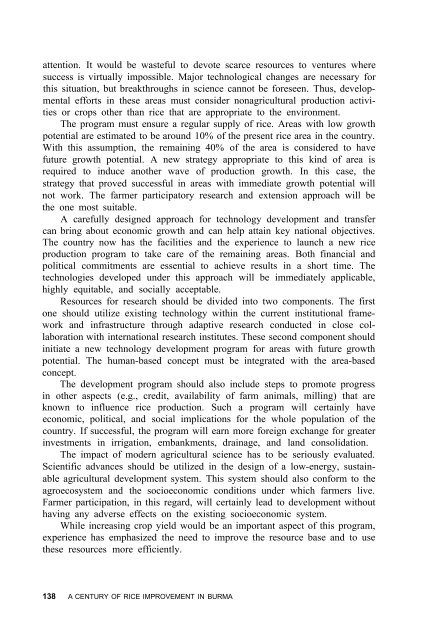A century of rice improvement in Burma - IRRI books - International ...
A century of rice improvement in Burma - IRRI books - International ...
A century of rice improvement in Burma - IRRI books - International ...
- No tags were found...
Create successful ePaper yourself
Turn your PDF publications into a flip-book with our unique Google optimized e-Paper software.
attention. It would be wasteful to devote scarce resources to ventures wheresuccess is virtually impossible. Major technological changes are necessary forthis situation, but breakthroughs <strong>in</strong> science cannot be foreseen. Thus, developmentalefforts <strong>in</strong> these areas must consider nonagricultural production activitiesor crops other than <strong>rice</strong> that are appropriate to the environment.The program must ensure a regular supply <strong>of</strong> <strong>rice</strong>. Areas with low growthpotential are estimated to be around 10% <strong>of</strong> the present <strong>rice</strong> area <strong>in</strong> the country.With this assumption, the rema<strong>in</strong><strong>in</strong>g 40% <strong>of</strong> the area is considered to havefuture growth potential. A new strategy appropriate to this k<strong>in</strong>d <strong>of</strong> area isrequired to <strong>in</strong>duce another wave <strong>of</strong> production growth. In this case, thestrategy that proved successful <strong>in</strong> areas with immediate growth potential willnot work. The farmer participatory research and extension approach will bethe one most suitable.A carefully designed approach for technology development and transfercan br<strong>in</strong>g about economic growth and can help atta<strong>in</strong> key national objectives.The country now has the facilities and the experience to launch a new <strong>rice</strong>production program to take care <strong>of</strong> the rema<strong>in</strong><strong>in</strong>g areas. Both f<strong>in</strong>ancial andpolitical commitments are essential to achieve results <strong>in</strong> a short time. Thetechnologies developed under this approach will be immediately applicable,highly equitable, and socially acceptable.Resources for research should be divided <strong>in</strong>to two components. The firstone should utilize exist<strong>in</strong>g technology with<strong>in</strong> the current <strong>in</strong>stitutional frameworkand <strong>in</strong>frastructure through adaptive research conducted <strong>in</strong> close collaborationwith <strong>in</strong>ternational research <strong>in</strong>stitutes. These second component should<strong>in</strong>itiate a new technology development program for areas with future growthpotential. The human-based concept must be <strong>in</strong>tegrated with the area-basedconcept.The development program should also <strong>in</strong>clude steps to promote progress<strong>in</strong> other aspects (e.g., credit, availability <strong>of</strong> farm animals, mill<strong>in</strong>g) that areknown to <strong>in</strong>fluence <strong>rice</strong> production. Such a program will certa<strong>in</strong>ly haveeconomic, political, and social implications for the whole population <strong>of</strong> thecountry. If successful, the program will earn more foreign exchange for greater<strong>in</strong>vestments <strong>in</strong> irrigation, embankments, dra<strong>in</strong>age, and land consolidation.The impact <strong>of</strong> modern agricultural science has to be seriously evaluated.Scientific advances should be utilized <strong>in</strong> the design <strong>of</strong> a low-energy, susta<strong>in</strong>ableagricultural development system. This system should also conform to theagroecosystem and the socioeconomic conditions under which farmers live.Farmer participation, <strong>in</strong> this regard, will certa<strong>in</strong>ly lead to development withouthav<strong>in</strong>g any adverse effects on the exist<strong>in</strong>g socioeconomic system.While <strong>in</strong>creas<strong>in</strong>g crop yield would be an important aspect <strong>of</strong> this program,experience has emphasized the need to improve the resource base and to usethese resources more efficiently.138 A CENTURY OF RICE IMPROVEMENT IN BURMA

















